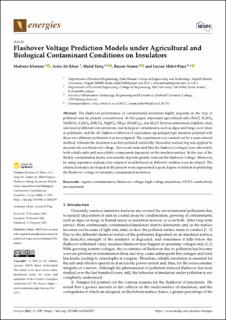Flashover Voltage Prediction Models under Agricultural and Biological Contaminated Condition on Insulators
| dc.contributor.author | Khatoon, Shabana | |
| dc.contributor.author | Khan, Asfar Ali | |
| dc.contributor.author | Tariq, Mohd | |
| dc.contributor.author | Alamri, Basem | |
| dc.contributor.author | Mihet-Popa, Lucian | |
| dc.date.accessioned | 2022-03-25T16:41:37Z | |
| dc.date.available | 2022-03-25T16:41:37Z | |
| dc.date.created | 2022-01-29T15:42:39Z | |
| dc.date.issued | 2022 | |
| dc.identifier.citation | Energies. 2022, 15 (4), Artikkel 1297. | en_US |
| dc.identifier.issn | 1996-1073 | |
| dc.identifier.uri | https://hdl.handle.net/11250/2987750 | |
| dc.description.abstract | The flashover performance of contaminated insulators highly depends on the type of pollutant and its present concentration. In this paper, important agricultural salts (NaCl, K2SO4, NaHCO3, CaSO4, KHCO3, MgSO4, NH4), 2Fe (SO4)2 , 6H2O (ferrous ammonium sulphate, dust and urea) at different concentration and biological contaminants such as algae and fungi were taken as pollutants, and AC flashover behaviour of porcelain cap and pin type insulator polluted with these two different pollutants was investigated. The experiment was carried out by a semi-natural method wherein the insulator was first polluted artificially thereafter natural fog was applied to measure the wet flashover voltage. Test results indicate that the flashover voltages were affected by both soluble salts and non-soluble components deposit on the insulator surface. In case of thick contaminated layer non-soluble deposits greatly reduced the flashover voltage. Moreover, by using regression analysis four empirical models based on different variables have been developed. The empirical models developed in the present work represent a good degree of relation to predicting the flash-over voltage of naturally contaminated insulators. | en_US |
| dc.language.iso | eng | en_US |
| dc.publisher | MDPI | en_US |
| dc.rights | Navngivelse 4.0 Internasjonal | * |
| dc.rights.uri | http://creativecommons.org/licenses/by/4.0/deed.no | * |
| dc.subject | organic contamination | en_US |
| dc.subject | flashover voltage | en_US |
| dc.subject | high-voltage insulators | en_US |
| dc.subject | ESDD | en_US |
| dc.subject | conductivity measurement | en_US |
| dc.title | Flashover Voltage Prediction Models under Agricultural and Biological Contaminated Condition on Insulators | en_US |
| dc.type | Peer reviewed | en_US |
| dc.type | Journal article | en_US |
| dc.description.version | publishedVersion | en_US |
| dc.rights.holder | © 2022 by the authors. | en_US |
| dc.subject.nsi | VDP::Teknologi: 500 | en_US |
| dc.source.volume | 15 | en_US |
| dc.source.journal | Energies | en_US |
| dc.source.issue | 4 | en_US |
| dc.identifier.doi | https://doi.org/10.3390/en15041297 | |
| dc.identifier.cristin | 1993178 | |
| dc.source.articlenumber | 1297 | en_US |
| cristin.ispublished | true | |
| cristin.fulltext | original | |
| cristin.qualitycode | 1 |

